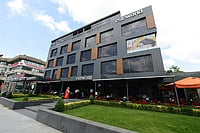Sprains, strains, and muscle spasms are common musculoskeletal injuries that can affect anyone, from elite athletes to everyday individuals.
While they may present with similar symptoms and causes, they impact different types of tissues.
Understanding the differences between these conditions and their causes, symptoms, and treatments can help manage and prevent them effectively.
Know the difference
A sprain is an injury to a ligament, whereas a strain involves damage to a muscle or tendon when these tissues are stretched or torn. A muscle spasm, or cramp, is a sudden, involuntary contraction of a muscle or group of muscles causing extreme pain lasting from a few seconds to several minutes.39
Sprains are more common in joints like the ankle, knee, and wrist, while strains frequently occur in the back, neck, and hamstring muscles. Some common sites of muscle spasms include the back, arms, legs, neck, chest, abdomen, and ribcage.40
Talking about the symptoms, symptoms of a sprain include:
Pain around the affected joint
Swelling and inflammation
Bruising or discoloration
Limited range of motion or difficulty moving the joint
A "popping" sensation at the time of injury
In a strain, a person experiences:
Pain or tenderness in the affected muscle or tendon
Swelling or inflammation
Muscle spasms or cramping
Limited range of motion or difficulty moving the affected area
Weakness or difficulty using the affected muscle
The symptoms of muscle spasms can vary from mild to severe, ranging from twitching to muscle tightening, similar to a cramp.40
What causes these muscle conditions?
Sprains occur due to:
Twisting or bending a joint in an awkward or sudden way
Falling and landing on an outstretched arm or leg
Getting hit or tackled during sports or physical activity
Overusing a joint through repetitive motions in certain activities
Strains can be caused by:
Overstretching or overusing a muscle
Lifting heavy objects improperly
Engaging in physical activity without adequate warm-up
Slipping or tripping and trying to regain balance suddenly
Poor posture or ergonomics
For Muscle Spasms:
Experts aren't exactly sure why some people get muscle spasms more than others. One or more of the following may be to blame in most cases:
Not enough stretching
Muscle fatigue
Exercising in extreme heat
Dehydration
Electrolyte imbalance
Stress
Too much high-intensity exercise
What to do?
When dealing with sprains, strains, and muscle spasms, taking immediate action can help reduce pain, limit damage, and promote faster recovery. Here are the essential steps to follow for each condition:
For Sprains and Strains (RICE method)
Rest: Stop any activity that involves the injured muscle or tendon to avoid worsening the strain.
Ice: Apply an ice pack to the injured area for 15-20 minutes every hour to reduce swelling and pain.
Compression: Wrap the joint with an elastic bandage to provide support and minimize swelling.
Elevation: Keep the injured limb raised above heart level to decrease swelling.
For Muscle Spasms
Stretch: Gently stretch and massage the affected muscle to relieve the spasm.
Hydrate: Drink plenty of water to help alleviate dehydration, which can cause spasms.
Heat or Cold: Apply a heating pad or ice pack to the muscle for 15-20 minutes to ease the pain.
Rest: Avoid strenuous activities that might aggravate the spasm.
If the injury or spasm is severe or doesn't improve with self-care, seek medical attention.
Preventing soft-tissue injuries
Injuries often occur when people suddenly increase the duration, intensity, or frequency of their activities. Many soft-tissue injuries can be prevented through proper conditioning and training. Other prevention tips include:
Use proper equipment. Replace your athletic shoes as they wear out.
Aim for balanced fitness and regular physical activity.
Ensure to warm up and cool down before and after any sports or physical activity.
Drink enough water to prevent dehydration, heat exhaustion, and heat stroke. Have a drink of water every 20 minutes or so while you exercise.
Schedule regular days off from vigorous exercise and rest when tired. Fatigue and pain are good reasons not to exercise.
Maintain a healthy body weight.
Issued in Public Interest by Dr.Reddy's Laboratories LTD






















